- School of Economics, Nanjing Audit University, Nanjing, China
This paper empirically describes and analyzes the structural contradictions between energy production and consumption in the Chinese local economy. Alongside rapid economic growth, energy usage in China increased gradually and exceeded energy production for a long time. For some particular energy sources such as petroleum, the gap between supply and demand is relatively larger than that of the whole energy sector in the economy. The process of turning fossil fuels into final energy products for use causes a great deal of pollution, especially emitting industrial waste gases, such as particulate matter emission, into the atmospheric environment. Increasing energy production directly and greatly to solve the gap between energy supply and demand in the economy may impact environmental quality and not meet sustainable development needs. It is difficult to coordinate energy production and consumption when considering economic development and environmental protection in economic operation. Importing energy could meet the excess energy consumption in a short period but often fluctuates from foreign energy market changes and global political events. For policy recommendations, some policies which directly lower energy consumption may impact economic development since industry is the main consumer of energy, and industrial production is an important component of GDP in China. Declining the role of the industry sector in the economy and reducing industrial product exports, including some energy-intensive products, could solve the structural contradictions between energy production and consumption under the condition of maintaining economic development and protecting the environment in China, but this is a long-term adjustment process.
Introduction
The Communist Party of China, established 100 years ago, has made great achievements in economic development during their leadership from 1 October 1949, when the People’s Republic of China was established, especially since 1978 when Chinese top designers decided to implement the reform and opening-up policy. Rapid economic growth in China has been ongoing for many years. The average growth rate of GDP and per capita GDP was 9.2 and 8.2%, respectively during 1979–2020 based on the information from the China Statistical Yearbook 2021, compiled by the National Bureau of Statistics of China1. The outbreak of the coronavirus disease in 2019 (COVID-19) and early 2020 has caused significant economic decline around the world. The Chinese economy has also been impacted by COVID-19, but its growth rate of GDP in 2020 was 2.3%, making it the only nation to achieve a positive growth rate among the major economies of the world based on the information from The Government Work Report 2021 by Premier Li Keqiang2. Economic development with a certain growth rate of GDP compliance with the Chinese people’s needs became a future policy goal. This paper takes this argument as the premise to study any issue, such as solving the structural contradictions between energy production and consumption. In other words, this study analyzes the dynamic changes in energy supply and demand in the process of economic development in China that are necessary since these issues have become an important section in many macro and micro policies.
The miracle of economic growth that occurred in China attracted the attention of researchers and policy-makers all over the world. People want to explore the factors driving Chinese economic growth to guide developing countries and regions with lower or even negative economic growth rates (Almås and Johnsen, 2018; Rodrik, 2018). Chen and Feng (2000) indicated that private and semi-private enterprises and international trade could play a role in Chinese economic growth, and higher education has the same effect. Liang and Teng (2006) mainly studied the relationship between Chinese financial development and economic growth, finding a unidirectional causality exists from economic growth to financial development which departs distinctively from other studies. Particularly, international trade is often regarded as a major factor driving economic growth in China (Kong et al., 2021), and innovation is the first driving force to shift the economy from rapid growth to high-quality development (Wang and Tan, 2021). However, along with China’s economic growth and social development, some public problems, such as the massive use of natural resources—including fossil fuels—and some serious environmental pollution events, have caused widespread concern around the world. In China’s economic growth model, energy consumption will increase with economic growth when the economy becomes more productive (Tang et al., 2018). As energy is an important input, its usage impacts economic development. Ren et al. (2022a) found the dynamic promotion effect of energy consumption on growth based on Chinese evidence. Fossil fuel energy and renewable energy use in Pakistan have a productive relationship with its economic progress (Rehman et al., 2022a), and the relation between commercial energy distribution and economic progress in this economy is also complex (Rehman et al., 2021a). Additionally, in China’s trade structure with industrial manufactured product exports, energy consumption also increases when the economy trades more goods to foreign countries and regions (Tang and Peng, 2017a). Pollution emission and energy consumption have a significantly positive relationship proven in some empirical studies (Zhang and Cheng, 2009; Wang et al., 2011). Some emissions, such as air pollution, may negatively impact people’s lives and human health by damaging environmental quality (Gu et al., 2020). Greenhouse gas emissions become an emerging problem globally; therefore, policymakers have to tackle this issue by implementing conservative policies and financial support (Rehman et al., 2021b).
In a new era since 2012, Chinese policymakers take meeting the people’s needs for a better life as a goal of governing the country. People want to live in a healthy environment without serious pollution, so policy implementers who exercise power on behalf of the state shall protect and improve the living and ecological environment along with preventing and controlling pollution, as written into the Constitution of the People’s Republic of China (Article 26). Hence, environmental protection is another basic assumption like economic development when analyzing how to solve the structure of energy production and consumption. The Central Committee of the CPC with Comrade Xi Jinping at the core adopts a new vision for development after the 18th National Congress of the CPC (8 November 2012). In the 19th National Congress of the CPC (18 October 2017), General Secretary Xi Jinping emphasized that the underpinning and the key to solving China’s problems is development, also indicating that the vision of innovative, coordinated, green, and open development for everyone is the new vision for development. The vision of green development includes the relationship between economic development and environmental protection, along with the rational use of energy and other natural resources at the top design level in China. In the process of economic operation, the relationship between economic development and pollution emission from some evidence shows that economic growth led to the deterioration of environmental quality in a certain stage of development (Grossman and Krueger, 1995). Policies and regulations for environmental protection may harm economic growth (Carraro and Galeotti, 1997). The contradiction between economic growth and environmental protection makes people feel that higher environmental quality necessitates a lower growth rate much of the times. To reduce carbon emissions for solving global climate change, correctly evaluating and forecasting carbon prices is important under the condition that the carbon market has become an effective mechanism (Ren et al., 2022b). Renewable energy consumption could reduce environmental degradation in some OECD countries (Dagar et al., 2022), and renewable energy consumption in Bhutan has an adverse relation to its carbon emissions (Rehman et al., 2022b). Some economies, like Argentina, have recently declared policies of carbon-neutral (Murshed et al., 2022a), renewable electricity generation, and economic globalization to reduce the energy production-related carbon emissions in the economy (Murshed et al., 2022b). Han et al. (2021) indicated that COVID-19 reduced fossil-related and cement-induced carbon dioxide along with significantly reduced GDP. To save energy and reduce emissions, low-carbon energy transition is conducive to stimulating energy poverty alleviation (Dong et al., 2021). In a word, controlling carbon emissions in some environmental policies will decline energy usage and promote to development of new energy with fewer emissions. Tang et al. (2014) proposed a model for environmental policy of resource reallocation and pollution control and indicated that an economy with economic growth has more ability to protect the environment. Ren et al. (2022c) indicated that some environmental rules do not improve environmental effects except the environmental regulations that directly target heavy polluting industries.
Due to the significant correlation between economic development and environmental quality, the structure of energy production and consumption is complicated. Additionally, energy production directly depends on the orientation of public energy policies, as impacted by social and economic development, and environmental protection, especially in China where the state owns all mineral resources according to the provisions of the Constitution (Tang, 2022). Many existing studies solely analyze the issue of energy consumption and economic development or energy production and environmental protection, etc. According to economic operation in practice, some issues of energy consumption and production need to be studied under the condition that the degree of economic growth and environmental protection is high or low. To the best of our knowledge, comprehensively analyzing the relation between energy production and consumption, and economic development and environmental protection to solve the gap between energy supply and demand in an economy is rare. Additionally, a policy with some instruments for controlling energy consumption or/and energy production with no concern for economic development and environmental protection is often difficult to implement. Compared to existing papers, this study mainly tries to address the policy level problem that some policies decline total energy consumption or/and increase total energy production to coordinate the structural contradictions between energy supply and demand in the Chinese local economy, likely influencing economic growth and environmental quality. Empirical analysis of the status and dynamic changes of energy production and consumption along with economic development and environmental protection based on the Chinese evidence could provide some clear policy recommendations to solve that problem. To achieve the results and to allow policy implications to be generalizable, this paper will study these issues with the vision of green and sustainable development.
Energy Production and Consumption in China: A General Description
Industrial production and human daily life need energy, which is a special product in an economy. Many economic resources, such as labor, technology, and financial capital, have been allocated by market power under the guidance of China’s market-oriented reform. However, energy allocation still has significant macro-control factors through implementation of policies and regulations regarding energy supply. The state or collectives as prescribed by law own all natural resources such as mineral resources, waters, forests, and mountains, and any organization or individual is prohibited to seize or damage natural resources based on Article 9 in the Constitution of the People’s Republic of China. The state-owned characteristic of mineral resources implies that private markets cannot solely solve the contradiction between energy supply and demand. Additionally, government control in China often influences energy prices (Shi and Sun, 2017), and the power of the market makes it difficult to adjust energy production and consumption. In China, energy consumption has exceeded production for many consecutive years. For example, Figure 1 depicts the total primary energy production and total energy consumption (standard quantity) during 2011–2020. The robust result indicated that the gap between energy consumption and production will become larger and larger in the Chinese local economy.
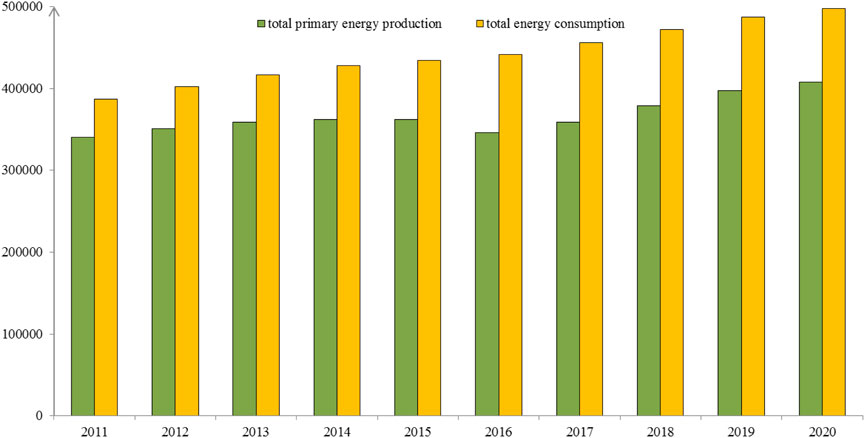
FIGURE 1. Total primary energy production and total energy consumption in China during 2011–2020 (104 tce). Source: The author searched the information from Total Primary Energy Production and Its Composition, and Total Energy Consumption and Its Composition in the China Statistical Yearbook 2021 respectively. Note: The unit “tce” indicates “ton coal equivalent”, and these quantities should be calculated by coal equivalent calculation based on the China Energy Statistical Yearbook 2020.
Energy demand or consumption significantly exceeded energy supply or production in China’s local economy. Energy prices should increase according to the theory of market economy. China’s policy-makers control energy prices strictly, and the producer price for energy products from the industry sector decreased in 2020, based on Figure 2. Energy consumption exceeded production and energy prices declining indicates that the structure between energy supply and demand in the domestic market is contradictory. Energy prices are still controlled at a relatively low level. Some energy producers possibly make losses by operating and decide to reduce or refuse production sometimes. Policy-makers in some Chinese regions had to take to power rationing3, which many developing countries often implement (Heggie et al., 2018). As a result of the energy market, there appears a power shortage and insufficient coal supply in China at the same time.
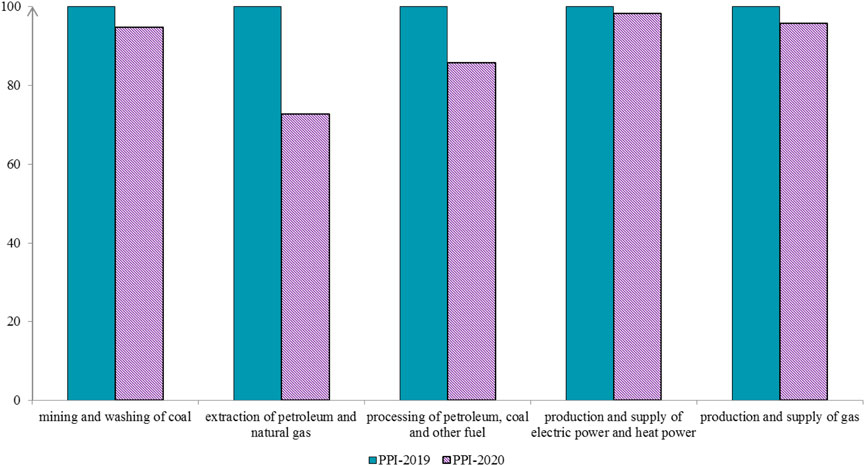
FIGURE 2. Producer price indices (PPI) for industrial products about energy in China in 2019 and 2020. Sources: The author searched the information from Producer Price Indices for Industrial Products by Sector (2020) in the China Price Statistical Yearbook 2021. Note: All industries’ PPI-2019 in the figure is 100.
When considering the internal structure of energy production and consumption in China, the contradiction between energy supply and demand in the domestic market will become more obvious. Energy, whether as a final product or an intermediate input in economic operation, needs particular natural resources existing in geology to produce. For example, if an economy wants to produce coal, petroleum, or natural gas for production or human daily use, it needs fossil fuels that were stored in the land. If the economy does not have fossil fuels on its land, it is difficult to produce some energy products in a closed economic model. Natural resources greatly constrain energy production in an economy. Thus, the structure of energy production has local characteristics. Figure 3 depicts the Chinese distribution of primary energy production in recent years and showed that raw coal accounted for the largest proportion of China’s energy production. China has verified a great number of coal reserves (Han et al., 2018), which is the main reason coal production was such a large proportion of energy production. However, the ratio of raw coal in primary energy production gradually declined in China, along with a larger and larger ratio of natural gas, primary electricity, and other energy. China has changed from a net exporter to a net importer of coal since 2009 (Tang and Peng, 2017b), and the import of coal was quite large at 29977 (104 tons) in 2019 according to the China Energy Statistical Yearbook 2020, and the export of coal in the same year was only 603 (104 tons). The ratio of crude oil in Figure 3 decreased on the whole (only increased in 2015), and the ratio in 2020 was only 6.8%. Comparing the composition of energy consumption could find whether the structure of energy production has more conflicts in China’s economic operation.
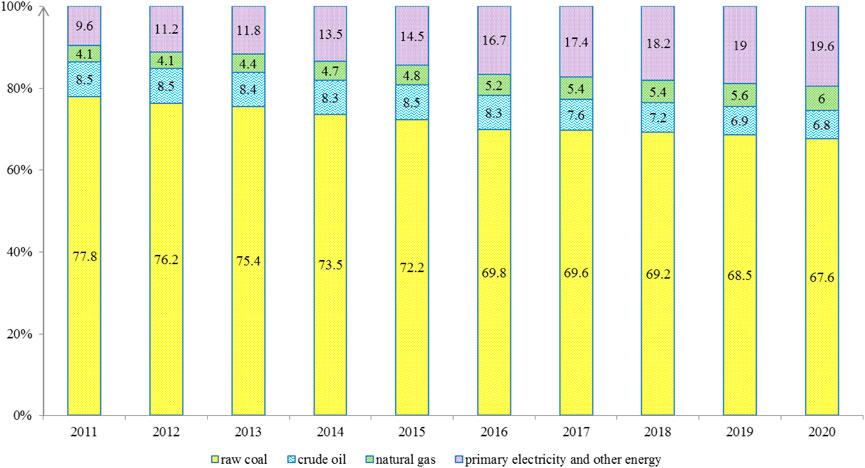
FIGURE 3. Composition of primary energy production in China during 2011–2020 (%). Source: The author searched the information from Total Primary Energy Production and Its Composition in the China Statistical Yearbook 2021.
Figure 4 shows the distribution of energy consumption in China during 2011–2020 and found the following: Coal accounted for the highest proportion of energy consumption and the percentage was greater than 50%, but the ratio declined gradually every year, which favors raw coal in primary energy production. Although these percentages of coal in Figure 4 were lower than raw coal percentages in Figure 3, China also imports coal to meet excess demand since total energy consumption was larger than primary energy production for many years, as illustrated in Figure 1. The percentages of natural gas and primary electricity and other energy in energy consumption increased gradually respectively and were consistent with their trends in energy production. The biggest inconsistency among these energy percentages in production and consumption was that the ratio of petroleum in energy consumption increased on the whole while the percentage of crude oil in energy production declined on the whole, and the former is much larger than the latter, such as the percentage of petroleum in energy consumption was 18.9% in 2020 and larger than crude oil in production, which had a percentage of 6.8%. Combining with the evidence that total energy consumption greatly exceeded total primary energy production, the petroleum gap in China is very large and meets the excess demand only through importing crude oil. The import of crude oil in China in 2019 was 50568 (104 tons), and the export of that was only 81 (104 tons) based on the China Energy Statistical Yearbook 2020.

FIGURE 4. Composition of energy consumption in China during 2011–2020 (%). Source: The author searched the information from Total Energy consumption and Its Composition in the China Statistical Yearbook 2021.
Importing energy such as coal and crude oil could solve some problems of energy supply and demand in an open economy model, but the structural contradictions between energy production and consumption are often associated with economic development and environmental protection. Additionally, the relatively robust composition of energy production and consumption in China indicated that the structural contradictions of energy supply and demand in the local economy will last for a long time. This paper will study the status of energy production and consumption with development and pollution in China, respectively, in the following sections. In many economic models, theoretically analyzing how economic growth impacts energy consumption and how energy usage influences environmental quality could provide some useful views for our empirical analysis. Additionally, some theoretical analyses of the energy market and energy prices could reveal the reasons for dynamic changes in energy production and consumption in theory.
Energy Production and Consumption With Economic Development in China
China’s policy-makers developed the economy and increased human income, which became the main objective after implementing the reform and opening-up policy in 1978 because people were eager to live a rich life. In the Chinese classic Guan Zi, it is said, “If the granary is full, people will understand etiquette; if the basic necessities of life are abundant, people will understand honor and shame.“4 In a poor and backward economy such as China before reform and opening-up, economic development with a high growth rate was a primary way to solve many social problems. In the stage of economic development in China, the rational use of energy and high environmental quality with low pollution is not as important as economic growth. Hence, China formed an economic model characterized by massive production and consumption of energy and other natural resources with massive pollution emissions. This traditional developing model is increasingly unsuitable after many years of rapid economic growth, so Chinese policy-makers began to emphasize the green development of energy-saving and emission reduction. The GDP growth rates declined gradually (slightly increasing in 2017) and was larger than the growth rates of energy consumption in China during 2011–2019 based on the information in Table 1. The energy intensity by GDP had been falling in recent years, which indicated that energy consumption per unit of output in China’s economy is declining. The growth rate of energy consumption firstly decreased and then increased on the whole. This situation probably is a result of energy as a final product increasing alongside increased income in people’s daily lives. For example, many families in China have one or more cars that need to use gasoline or electricity, and the total number of civil motor vehicles was an incredible number—25376 (104units) in 2019, based on the China Energy Statistical Yearbook 2020.

TABLE 1. Growth rate of energy production, energy consumption and GDP, and the energy intensity by GDP in China during 2011–2019.
Policy objectives have obviously impacted energy production since the Chinese state owns the fossil fuels. With the economic growth, the growth rate of energy production in China in 2016 was negative (−4.5%). Energy production reduction is contradictory to the increase in energy consumption, especially as the Chinese economy had excess energy demand compared to energy supply in the domestic market for many years. Policies to reduce energy consumption are difficult to implement because industrial production and people’s daily lives requireenergy. As a necessary factor, production cannot be maintained without energy usage; as a necessary product, people cannot live normally without gasoline or natural gas. Declining energy production policies are relatively easy to implement by formulating stricter regulations of fossil fuel exploitation and hope to solve the gap between energy supply and demand by importing energy from the foreign market. However, the model of reducing energy production regardless of energy usage was hard to sustain for a long time since energy consumption increases with economic development and the excess energy demand in the domestic market becomes greater, and energy import is likely to be seriously impacted by the international energy market. The growth rates of energy production in China in 2017–2019 were positive and larger than the growth rate of energy consumption in the 3 years, respectively.
Fossil fuels stored in nature have to go through a series of production processes to become usable energy products. Thus, some industries around energy production become important sections of the economy. In the economic model with Chinese characteristics, output in the industrial sector is the most important component of GDP, and as such the percentage of the industry sector of the GDP in 2020 is the largest at 30.8%, shown in Figure 5. Too strict restrictions on energy production may lead to a decline in industrial output, which is not conducive to economic development owing to the decline of energy industry employment alongside with energy production reduction.
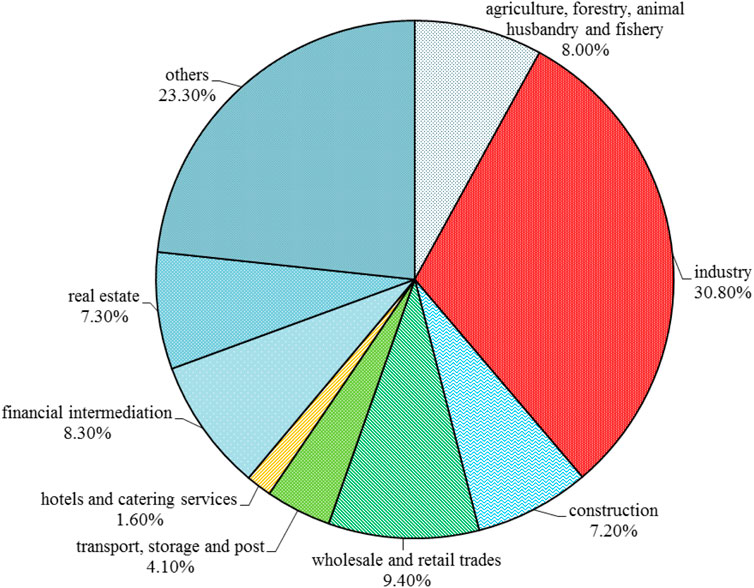
FIGURE 5. Composition of GDP by sector in China, 2020. Source: The author searched the information from GDP Composition in the China Statistical Yearbook 2021.
In the industrial sector, the industry around energy encompasses mining and washing of coal, extraction of petroleum and natural gas, processing of petroleum, coal, and other fuels, production and supply of electric power and heat power, and production and supply of gas5, as introduced in Figure 2. The industry of processing petroleum, coal, and other fuels belongs to the manufacturing sector, and its total profit was 103.49 billion yuan and the average number of employees per year was 804 thousand persons in China in 2020 based on the information in the China Statistical Yearbook 2021. Policy-makers have difficulty limiting this industry’s production when its operating performance is so remarkable. A strange phenomenon appeared in China’s energy production as follows: The economy imported a huge amount of crude oil for meeting the excess petroleum demand but exported a large number of final petroleum products, such as gasoline, kerosene, and diesel oil, at the same time. Figure 6 depicts the net export of gasoline, kerosene, and diesel oil in China from 2014 through 2019, showing that the net exports of these final petroleum products increased on the whole. A crude oil-importing country exporting more and more final petroleum products indicates that the economy could obtain benefits from processing petroleum in production.
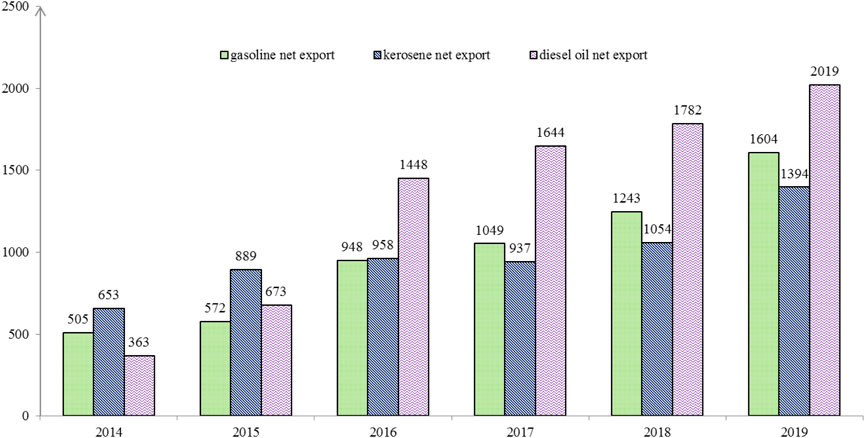
FIGURE 6. Net export of gasoline, kerosene, and diesel oil in China during 2014–2019 (104 tons). Source: The author searched those exports and imports from Imports and Exports of Major Energy Products in the China Energy Statistical Yearbook 2020 and calculated these net exports.
For energy consumption, the percentage of energy usage in the industry sector on total energy consumption exceeded 65% in China from 2011 through 2019, shown in Figure 7. Due to the importance of the industrial sector to China’s economic development, some regulations of strictly reducing energy consumption in the industry sector have an obvious effect of saving energy but declines in industrial production are likely to stop the implementation of these policies for some time. The result is robust in Figure 7.
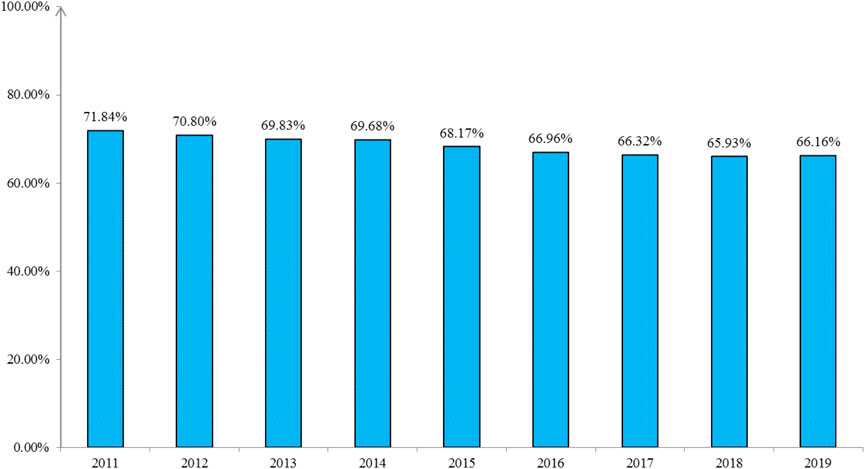
FIGURE 7. Percentage of energy consumption in industry on total energy consumption in China during 2011–2019. Source: The author searched the total energy consumption and energy consumption in industry from Total Energy Consumption by Sector in the China Energy Statistical Yearbook 2020 and calculated these percentages.
Exporting industrial products became the primary section of China’s goods trade; total goods exports in China 2020 were USD 2589.952 billion and the export of industrial products was USD 2474.322 billion, based on the China Statistical Yearbook 2021, so the percentage of industrial products of total goods export exceeded 95.5%. Energy consumption focused on industrial production and industrial commodities export was the main section of goods export, so a decline in industrial products export should reduce energy usage and solve the pressure of short energy supply to a certain extent. When commodity export is still the main determinant of China’s economic development, energy usage in the industrial sector will continue contributing to foreign markets through goods exports (Tang and Peng, 2017a), because energy consumption in the economy is difficult to decrease by reducing industrial product exports in the future. Table 2 presents some energy-intensive products produced in the industrial sector in China during 2011–2019 and indicated that these products’ exports from China were relatively great. Only the export of cement and cement clinkers in 2019 was lower than that in 2011, and all other energy-intensive product exports in 2019 were more than in 2011. Producing these energy-intensive products in China necessarily used a lot of energy. The export of these products increased on the whole and expanded the structural contradictions between energy production and consumption at the level of economic development. The relatively robust growth trend indicates that declining the export of these energy-intensive products requires a long time.
Overall, industrial production and industrial product exports are highly related to China’s economic development and huge energy consumption in the industry sector. Considerable performance of energy production in the relevant industries caused energy consumption to reduce difficultly, so energy saving cannot be achieved by declining energy supply alone. Additionally, energy as a final product was consumed more in people’s daily life when family income increased with economic development, which was also a cause of expanding contradiction between energy production and consumption. The traditional economic growth model characterized by massive production and consumption and large industrial products export must change in China. Otherwise, it cannot effectively solve the contradiction between energy supply and usage.
Energy Production and Consumption With Environmental Protection in China
With many years of sustained economic growth in China, Chinese people have higher requirements for environmental quality, such as clean air and water. In the basic economic analysis framework, the demand for any normal goods will increase along with income increases. However, the private market cannot solve the allocation of environmental quality problems, owing to the public goods model. The government must ensure the environmental quality people require and prevent serious environmental pollution as much as possible. Excessive discharge of waste water and emission of waste gas in some regions of China is a major environmental challenge at the state level. To compare energy production and consumption, which relates to the industry sector, with economic development, Figure 8 depicts the percentage distribution of pollution discharged into water and emitted into the atmosphere in China in 2019. The discharge of waste water containing COD and ammonia nitrogen from the industrial sector is relatively low. According to the raw data, discharge of COD and ammonia nitrogen mainly came from households. However, the emission of waste gas such as sulfur dioxide, nitrogen oxides, and particulate matter from the industry sector is very large, especially sulfur dioxide and particulate matter emissions. Huge emissions of industrial waste gas and energy, including fossil fuel, mainly used in the industrial sector are related. When energy consumption in industrial production is difficult to reduce for economic development in China, there is a challenge to atmospheric environmental protection.
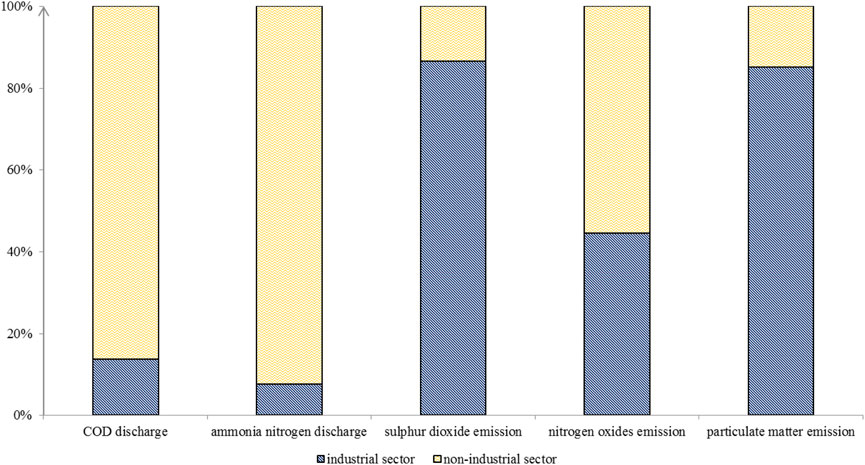
FIGURE 8. Composition of some pollutants’ discharged into water and emitted into the atmosphere in China in 2019. Source: The author searched the total quantities of pollution and the number in the industrial sector in the China Statistical Yearbook on Environment 2020 and calculated pollution in the non-industrial sector, then devised this figure. Note: The “COD” in the figure indicates “Chemical Oxygen Demand”.
Although the proportion of industrial discharge on total waste water is relatively small, industries surounding energy production also discharged waste water, and collated numbers in China in 2019 are shown in Table 3. Based on the calculation of the percentage of these industries’ COD and ammonia nitrogen discharge on the total industrial discharge, both percentages of COD and ammonia nitrogen in the processing of petroleum, coal, and other fuels, and the production and supply of electric power and heat power were relatively large. The percentage of COD in mining and washing of coal was also large. Hence, when policy-makers want to reduce the discharge of waste water for environmental protection in the level of energy production, implementing some regulation adjustments in the extraction of petroleum and natural gas or production and supply of gas solely is difficult to achieve a significant effect at the stage of development in China.

TABLE 3. Discharge of industrial waste-water and its percentage in some industries about energy in China 2019.
Figure 9 depicts the energy produced in the industry sector and the emissions of waste gas in these industries about energy production in China in 2019. In the sector of extraction of petroleum and natural gas and production and supply of gas, the emission of sulfur dioxide, nitrogen oxides, and particulate matter is relatively low. These three emissions arising from the processing of petroleum, coal, and other fuels, and production and supply of electric power and heat power were relatively large, and particulate matter emission in the mining and washing of coal was also large. In a word, in producing energy for economic operation and daily life, the process of production may impact atmospheric environmental quality by emitting waste gases. For higher environmental quality, strictly reducing energy production could decline the emission of waste gas but expand the structural contradictions between energy supply and usage in China. Put differently, meeting the excess energy demand in the domestic market by producing more energy in the Chinese local economy may directly damage the environmental quality.
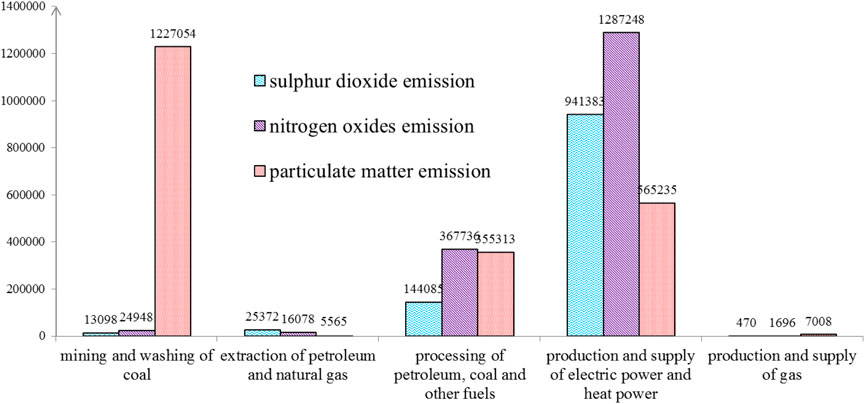
FIGURE 9. Emission of industrial waste gas in industries surrounding energy in China, 2019 (ton). Source: The author searched the information from Emission of Industrial Waste gas by Sector in the China Statistical Yearbook on Environment 2020.
Huge energy consumption in the whole industry sector and energy production for economic development indicates that some environmental protection policies with strictly declining energy usage/supply implement difficultly. However, reducing pollution emissions does not impact economic development as significantly as declining energy consumption under the condition of more and more advanced pollution control technology being used. For example, at the energy production level, producers could reduce pollution emissions by using some treatment facilities while maintaining energy production unchanged. Table 4 shows the collated number and annual expenditure of industrial waste-water and gas treatment facilities for energy industries in China in 2019. These produced energy industries invested a lot of money in controlling pollution, such as the production and supply of electric power and heat power industry had 21,140 set treatment facilities and paid about 73.6 billion yuan to treat industrial waste gas in 2019. Energy industries treating polluting emissions could alleviate the impact of energy production on the environment. Furthermore, all industries treating pollution will reduce some emissions from the process of energy consumption and achieve the effect of environmental protection.

TABLE 4. Number and annual expenditure of industrial waste-water and waste gas treatment facilities in some industries about energy in China 2019.
While industrial production with huge energy consumption and pollution emissions exist, treating these emissions will also bring with it some problems, such as the pollution treatment technology may have limitations, and the cost of treatment will be higher than no treatment. More importantly, this way of only treating pollution cannot reduce energy consumption. Thus, the structural contradictions between energy production and usage still exist.
Policy Implications
Findings
In order to present appropriate policy implications, Table 5 summarizes these main findings as empirically analyzed above.
These findings based on Chinese evidence have some important policy implications when policymakers are focusing on energy conservation, economic development, and environmental quality in practice.
Optimizing the Economic Structure by Declining the Role of Industry
Along with China’s economic development, energy demand has exceeded supply in the local economy for many years, and the gap between production and consumption of some special energy such as crude oil and petroleum was more obvious. To solve the structural contradictions between energy production and consumption, increasing production or/and reducing consumption would seem to be a simple way. However, for economic development and environmental protection, the method is hard to implement for a long time. In particular, industrial production with its huge energy usage contributes to economic growth and emits great amounts of waste gases. Declining production in the industry sector must have a significant effect on the level of energy conservation and emission reduction, but it goes against the goal of economic development in maintaining a certain growth rate in China. Fortunately, the percentage of the industrial sector on GDP in China decreased gradually (except in 2017), as shown in Figure 10. The result is also robust in Figure 10. The role of industrial production is declining relatively, helping to reduce energy consumption and waste gas emissions on the condition of maintaining economic development, which could also meet the excess energy demand. Directly reducing industrial production is still infeasible to implement in China, thus, adjusting the economic structure to solve the gap between energy supply and demand needs a long time.
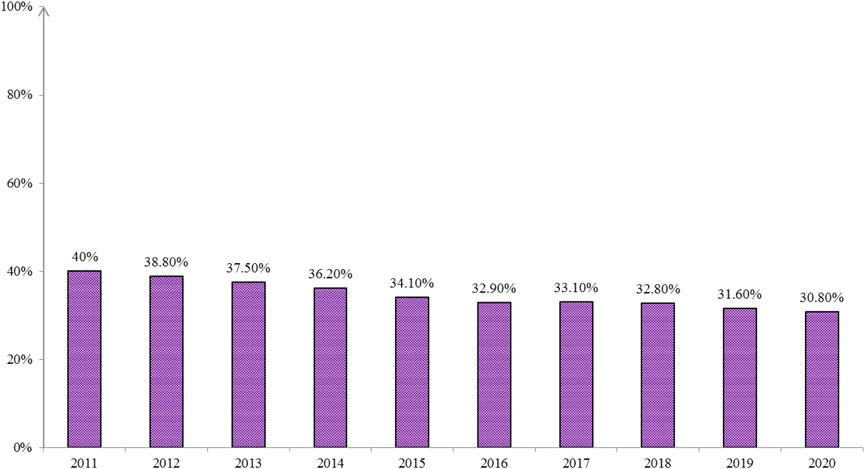
FIGURE 10. Percentage of industry sector on GDP in China during 2011–2020.Source: The author searched the information from GDP Composition in the China Statistical Yearbook 2021.
Importing Energy From Foreign Markets Is Only a Short-Term Method
Increasing energy production in the local economy could solve the gap between energy supply and demand in China, but this method is detrimental to the sustainable exploitation of natural resources such as fossil fuels. According to the coal reserves and the production conditions, China increases coal production to meet the excess coal demand easily. Policy-makers required the reduction of coal production capacity and deceleration of the growth rate of coal production, even directly reducing coal production in China during 2014–2016 compared with their previous years, respectively, based on the coal balance sheet in the China Energy Statistical Yearbook 2020. The gap between coal supply and demand became larger and larger. Thus, China had to import a huge amount of coal from foreign economies. Although importing energy could solve the problem of insufficient energy production, the domestic energy market may have serious fluctuations from an international energy supply shortage or some political events. Hence, reducing energy consumption is more feasible than increasing energy supply by importing energy in the long term.
Implementing Proper Policies With the Vision of Green and Sustainable Development
Energy, as a final product, is something people use every day. Many energy products come from nonrenewable natural resources, and their sustainable use is very important. Many philosophers put forward views of ecological protection and sustainable development in ancient China. For example, in the Chinese classic The Works of Mencius, Mencius said, “If close nets are not allowed to enter the pools and ponds, the fishes and turtles will be more than can be consumed. If the axes and bills enter the hills and forests only at the proper time, the wood will be more than can be used.“6 Enhancing people’s awareness of energy conservation, such as saving electricity, could reduce energy consumption. Economic development could operate in tandem with proper energy production and consumption, and humanity and nature could coexist in harmony through environmental protection when people and industrial producers have a high awareness of energy conservation, environmental protection, and ecology. For atmospheric protection, some emissions have adverse effects on the environment, especially some emissions associated with fossil fuels (polluting energy) like carbon dioxide and other greenhouse gases (Rehman et al., 2021c). However, the total consumption of some specific energy, such as coal in Pakistan, has a productive relation to economic growth (Rehman et al., 2021d). Hence, the huge usage of fossil energy in some developing economies, including China, generates great environmental pressure and will remailn tied to economic development for a long period. Implementing policies to solve the structural contradictions between energy production and consumption should be established the vision of green and sustainable development in the future.
Exporting industrial products, including some energy-intensive goods, led China to consume more energy compared to the economy’s self-operation. Rehman et al. (2021e) indicated that globalization becomes an undeniable factor from pollution to climate change with global warming. The decline in industrial products export will reduce energy usage and relieve the contradiction between energy production and consumption. Reducing industrial production at the overall level may impact economic development, and adjusting the structure of export products with declining industrial products has a smaller influence on economic operation. Implementing some policies to lead the economy to not rely too deeply on the export of industrial products, especially some energy-intensive export products, could reduce energy consumption and have continuous effects in the long term. Additionally, some technologies need be innovated in industrial production to have cleaner characteristics with less energy usage and polluting emissions. Fiscal policies about technological innovation cannot support those technologies characterized by massive input and massive emissions. Developing cleaner technology is probably an effective way to solve the structural contradictions between energy production and consumption under the condition of maintaining economic development and environmental quality when industrial production is still important in China. In a word, any policy with an increase or decline in energy production or energy consumption in China must take the goal of economic development and environmental protection into consideration. Otherwise, it may be difficult to implement persistently in the long term when the Chinese economy is still developing.
Concluding Remarks
Chinese policy-makers have paid more attention to green development in a new era. Huge energy consumption in the economy leads to air pollution in the process of industrial production, so declining energy usage meets the requirements of green development. Reducing energy usage directly is likely to negatively impact growth, which is still a key factor in economic development. Mineral resources, including fossil fuels owned by the state, indicate that the government controls energy production, which is therefore easier to control in China than energy usage. Policy-makers want to ramp down overcapacity, such as in coal production. However, Chinese energy demand exceeded supply in the local economy and over-relied on energy imports. Additionally, great industrial product exports increased energy usage compared to other export types. For economic development, Chinese policymakers cannot rapidly reduce industrial product exports in the short term and will not directly reduce industrial production. The structural contradictions between energy production and consumption with economic development indicate that realizing the coordination of natural resources, including fossil fuels and their production activities, by adjusting the economic structure and reducing the role of heavy industry in the GDP of China requires many years. Environmental protection objectives and a high-quality development strategy means Chinese policy-makers no longer only focus on high growth rates. When China can accept a relatively lower growth rate in the future, solving the structural contradictions between energy production and consumption will be easier by declining the proportion of industrial production in the economy. In a word, energy consumption with economic development does not decline in China at present. Solely increasing energy production is also unrealistic, accompanied by increasing environmental pressure. HERE.
For policy recommendations, meets the excess energy demand in the Chinese local economy could be achieved through energy import in a short period. Any policy of energy production and/or energy consumption in China can be implemented steadily when considering the goal of economic development, and environmental protection issues could not be ignored. Declining the total energy usage by optimizing economic structure and implementing reduction in energy intensity per unit of GDP is an important method for solving the structural contradictions between energy production and consumption. Some environmental regulations and economic policies with the vision of green development and sustainable development will also influence energy production or/and energy consumption. Hence, some macro and micro policies regarding energy should be properly implemented in the process of economic development with environmental protection.
This paper mainly studies the structure and status of energy production and consumption through longitudinal time analysis in an economy, i.e. the Chinese local economy; therefore, this work being conducted in the absence of horizontal comparison is a limitation. It is difficult to empirically analyze the issues contained within energy production, energy consumption, economic development, and environmental protection in many economies simultaneously, but this may be achieved in further work and conclude more significant conclusions with global sustainable development in the future.
Data Availability Statement
The original contributions presented in the study are included in the article/supplementary material, further inquiries can be directed to the corresponding author.
Author Contributions
The author confirms being the sole contributor of this work and has approved it for publication.
Conflict of Interest
The author declares that the research was conducted in the absence of any commercial or financial relationships that could be construed as a potential conflict of interest.
Publisher’s Note
All claims expressed in this article are solely those of the authors and do not necessarily represent those of their affiliated organizations, or those of the publisher, the editors and the reviewers. Any product that may be evaluated in this article, or claim that may be made by its manufacturer, is not guaranteed or endorsed by the publisher.
Footnotes
1These data could be found at http://www.stats.gov.cn/tjsj/ndsj/.
2According to the information from the National Bureau of Statistics in China, the final growth rate of GDP in 2020 was 2.2%. For details, see http://www.stats.gov.cn/xxgk/sjfb/zxfb2020/202112/t20211217_1825447.html.
3Some reports could be seen at http://www.nea.gov.cn/2021-11/12/c_1310307217.htm.
4This is English version translated by Jonathan Price and Menghui Yan and published by Shandong Friendship Publishing House in 2008
5In China Energy Statistical Yearbook, energy industry contains coal mining and processing, petroleum and natural gas extraction, electricity, steam, hot water producing and supply, petroleum processing and coking, and coal gas and coal products, etc. In order to analyze some topics by collecting available data and evidence, this paper uses the industry about energy such as in Figure 2.
6This is English version translated by James Legge (1815–1897) who was a Scottish sinologist and published by Liaoning People’s Publishing House in 2017.
References
Almås, I., and Johnsen, Å. (2018). The Cost of a Growth Miracle – Reassessing Price and Poverty Trends in China. Rev. Econ. Dyn. 30, 239–264. doi:10.1016/j.red.2018.05.006
Carraro, C., and Galeotti, M. (1997). Economic Growth, International Competitiveness and Environmental Protection: R & D and Innovation Strategies with the WARM Model. Energy Econ. 19 (1), 2–28. doi:10.1016/s0140-9883(96)01005-5
Chen, B., and Feng, Y. (2000). Determinants of Economic Growth in China: Private Enterprise, Education, and Openness. China Econ. Rev. 11 (1), 1–15. doi:10.1016/s1043-951x(99)00014-0
Dagar, V., Khan, M. K., Alvarado, R., Rehman, A., Irfan, M., Adekoya, O. B., et al. (2022). Impact of Renewable Energy Consumption, Financial Development and Natural Resources on Environmental Degradation in OECD Countries with Dynamic Panel Data. Environ. Sci. Pollut. Res. 29, 18202–18212. doi:10.1007/s11356-021-16861-4
Dong, K., Ren, X., and Zhao, J. (2021). How Does Low-Carbon Energy Transition Alleviate Energy Poverty in China? A Nonparametric Panel Causality Analysis. Energy Econ. 103, 105620. doi:10.1016/j.eneco.2021.105620
Grossman, G. M., and Krueger, A. B. (1995). Economic Growth and the Environment. Q. J. Econ. 110 (2), 353–377. doi:10.2307/2118443
Gu, H., Yan, W., Elahi, E., and Cao, Y. (2020). Air Pollution Risks Human Mental Health: an Implication of Two-Stages Least Squares Estimation of Interaction Effects. Environ. Sci. Pollut. Res. 27, 2036–2043. doi:10.1007/s11356-019-06612-x
Han, S., Chen, H., Long, R., and Cui, X. (2018). Peak Coal in China: A Literature Review. Resour. Conserv. Recycl. 129, 293–306. doi:10.1016/j.resconrec.2016.08.012
Han, P., Cai, Q., Oda, T., Zeng, N., Shan, Y., Lin, X., et al. (2021). Assessing the Recent Impact of COVID-19 on Carbon Emissions from China Using Domestic Economic Data. Sci. Total Environ. 750, 141688. doi:10.1016/j.scitotenv.2020.141688
Heggie, A., Eager, D., McKinnon, K., and Van Der Weijde, A. H. (2018). Power Rationing in a Long-Term Power Shortage. Energy Policy 121, 202–210. doi:10.1016/j.enpol.2018.06.025
Kong, Q., Peng, D., Ni, Y., Jiang, X., and Wang, Z. (2021). Trade Openness and Economic Growth Quality of China: Empirical Analysis Using ARDL Model. Finance Res. Lett. 38, 101488. doi:10.1016/j.frl.2020.101488
Liang, Q., and Teng, J.-Z. (2006). Financial Development and Economic Growth: Evidence from China. China Econ. Rev. 17 (4), 395–411. doi:10.1016/j.chieco.2005.09.003
Murshed, M., Mahmood, H., Ahmad, P., Rehman, A., and Alam, M. S. (2022a). Pathways to Argentina's 2050 Carbon-Neutrality Agenda: the Roles of Renewable Energy Transition and Trade Globalization. Environ. Sci. Pollut. Res. 29, 29949–29966. doi:10.1007/s11356-021-17903-7
Murshed, M., Rashid, S., Ulucak, R., Dagar, V., Rehman, A., Alvarado, R., et al. (2022b). Mitigating Energy Production-Based Carbon Dioxide Emissions in Argentina: the Roles of Renewable Energy and Economic Globalization. Environ. Sci. Pollut. Res. 29, 16939–16958. doi:10.1007/s11356-021-16867-y
Rehman, A., Ozcan, R., Badshah, W., Radulescu, M., and Ozturk, I. (2021a). Symmetric and Asymmetric Impacts of Commercial Energy Distribution from Key Sources on Economic Progress in Pakistan. Sustainability 13 (22), 12670. doi:10.3390/su132212670
Rehman, A., Ma, H., Radulescu, M., Sinisi, C. I., Paunescu, L. M., Alam, M. S., et al. (2021b). The Energy Mix Dilemma and Environmental Sustainability: Interaction Among Greenhouse Gas Emissions, Nuclear Energy, Urban Agglomeration, and Economic Growth. Energies 14 (22), 7703. doi:10.3390/en14227703
Rehman, A., Ma, H., Ahmad, M., Ozturk, I., and Işık, C. (2021c). An Asymmetrical Analysis to Explore the Dynamic Impacts of CO2 Emission to Renewable Energy, Expenditures, Foreign Direct Investment, and Trade in Pakistan. Environ. Sci. Pollut. Res. 28 (38), 53520–53532. doi:10.1007/s11356-021-14537-7
Rehman, A., Ma, H., Radulescu, M., Sinisi, C. I., and Yousaf, Z. (2021d). Energy Crisis in Pakistan and Economic Progress: Decoupling the Impact of Coal Energy Consumption in Power and Brick Kilns. Mathematics 9 (17), 2083. doi:10.3390/math9172083
Rehman, A., Radulescu, M., Ma, H., Dagar, V., Hussain, I., and Khan, M. (2021e). The Impact of Globalization, Energy Use, and Trade on Ecological Footprint in Pakistan: Does Environmental Sustainability Exist? Energies 14 (17), 5234. doi:10.3390/en14175234
Rehman, A., Ma, H., Ozturk, I., and Radulescu, M. (2022a). Revealing the Dynamic Effects of Fossil Fuel Energy, Nuclear Energy, Renewable Energy, and Carbon Emissions on Pakistan’s Economic Growth. Environ. Sci. Pollut. Res., 1–11. doi:10.1007/s11356-022-19317-5
Rehman, A., Alam, M. M., Radulescu, M., Alvarado, R., Mihai, D., and Brutu, M. (2022b). A Novel Investigation to Explore the Impact of Renewable Energy, Urbanization, and Trade on Carbon Emission in Bhutan. Energies 15 (9), 2984. doi:10.3390/en15092984
Ren, X., Tong, Z., Sun, X., and Yan, C. (2022a). Dynamic Impacts of Energy Consumption on Economic Growth in China: Evidence from a Non-parametric Panel Data Model. Energy Econ. 107, 105855. doi:10.1016/j.eneco.2022.105855
Ren, X., Duan, K., Tao, L., Shi, Y., and Yan, C. (2022b). Carbon Prices Forecasting in Quantiles. Energy Econ. 108, 105862. doi:10.1016/j.eneco.2022.105862
Ren, X., Li, Y., Shahbaz, M., Dong, K., and Lu, Z. (2022c). Climate Risk and Corporate Environmental Performance: Empirical Evidence from China. Sustain. Prod. Consum. 30, 467–477. doi:10.1016/j.spc.2021.12.023
Shi, X., and Sun, S. (2017). Energy Price, Regulatory Price Distortion and Economic Growth: A Case Study of China. Energy Econ. 63, 261–271. doi:10.1016/j.eneco.2017.02.006
Tang, E., and Peng, C. (2017a). The Global Contribution of Energy Consumption by Product Exports from China. Environ. Sci. Pollut. Res. 24 (17), 14690–14699. doi:10.1007/s11356-017-9074-6
Tang, E., and Peng, C. (2017b). A Macro- and Microeconomic Analysis of Coal Production in China. Resour. Policy 51, 234–242. doi:10.1016/j.resourpol.2017.01.007
Tang, E., Liu, F., Zhang, J., and Yu, J. (2014). A Model to Analyze the Environmental Policy of Resource Reallocation and Pollution Control Based on Firms' Heterogeneity. Resour. Policy 39, 88–91. doi:10.1016/j.resourpol.2013.12.001
Tang, E., Peng, C., and Xu, Y. (2018). Changes of Energy Consumption with Economic Development when an Economy Becomes More Productive. J. Clean. Prod. 196, 788–795. doi:10.1016/j.jclepro.2018.06.101
Tang, E. (2022). Development of New Products and Energy Consumption in Industrial Production: Relationship and Evidence from China. Front. Energy Res. 10, 895551. doi:10.3389/fenrg.2022.895551
Wang, R., and Tan, J. (2021). Exploring the Coupling and Forecasting of Financial Development, Technological Innovation, and Economic Growth. Technol. Forecast. Soc. Change 163, 120466. doi:10.1016/j.techfore.2020.120466
Wang, S. S., Zhou, D. Q., Zhou, P., and Wang, Q. W. (2011). CO2 Emissions, Energy Consumption and Economic Growth in China: A Panel Data Analysis. Energy Policy 39 (9), 4870–4875. doi:10.1016/j.enpol.2011.06.032
Keywords: energy production, energy consumption, economic development, environmental protection, Chinese evidence
Citation: Tang E (2022) Structural Contradictions Between Energy Production and Consumption Along With Economic Development and Environmental Protection in China: Evidence and Policy Implications. Front. Environ. Sci. 10:919869. doi: 10.3389/fenvs.2022.919869
Received: 14 April 2022; Accepted: 24 May 2022;
Published: 29 June 2022.
Edited by:
Mobeen Ur Rehman, Shaheed Zulfikar Ali Bhutto Institute of Science and Technology (SZABIST), United Arab EmiratesReviewed by:
Abdul Rehman, Henan Agricultural University, ChinaBongsuk Sung, Kyonggi University, South Korea
Xiaohang Ren, Central South University, China
Copyright © 2022 Tang. This is an open-access article distributed under the terms of the Creative Commons Attribution License (CC BY). The use, distribution or reproduction in other forums is permitted, provided the original author(s) and the copyright owner(s) are credited and that the original publication in this journal is cited, in accordance with accepted academic practice. No use, distribution or reproduction is permitted which does not comply with these terms.
*Correspondence: Erzi Tang, dGFuZ2VyemlfbmF1QDEyNi5jb20=
 Erzi Tang
Erzi Tang
